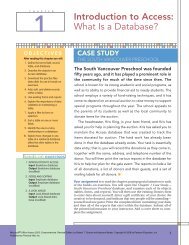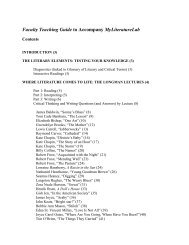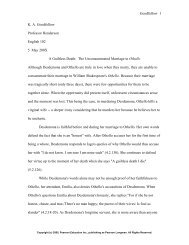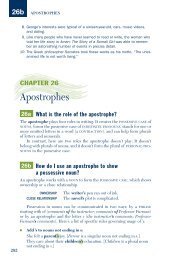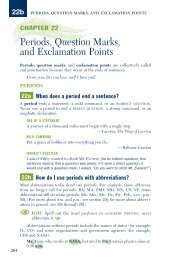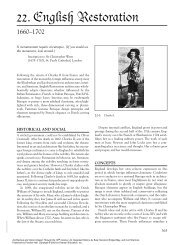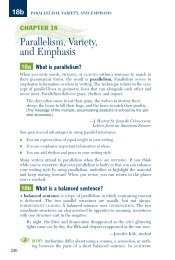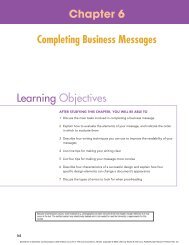Chapter 41: Word Order eBook
Chapter 41: Word Order eBook
Chapter 41: Word Order eBook
Create successful ePaper yourself
Turn your PDF publications into a flip-book with our unique Google optimized e-Paper software.
How can I understand the placement of adverbs?<br />
<strong>41</strong>c<br />
<strong>Word</strong> order for more than one adjective (continued)<br />
6. Adjectives of age or condition, if any: new, young, broken, dirty,<br />
shiny, and so on<br />
7. Adjectives of color, if any: red, green, blue, and so on<br />
8. Adjectives that can also be used as nouns, if any: French,<br />
Protestant, metal, cotton, and so on<br />
9. The noun<br />
1 2 3 4 5 6 7 8 9<br />
a few tiny red ants<br />
the last six Thai carvings<br />
my fine old oak table<br />
<strong>41</strong>c<br />
How can I understand the placement<br />
of adverbs?<br />
ADVERBS modify—describe or limit—VERBS, ADJECTIVES, other adverbs, or<br />
entire sentences (see 7f). Adverbs may be positioned first, in the middle, or<br />
last in CLAUSES. Box <strong>41</strong>-2 summarizes adverb types, what they tell about the<br />
words they modify, and where each type can be placed.<br />
BOX <strong>41</strong>-2<br />
SUMMARY<br />
Types of adverbs and where to position them<br />
ADVERBS describe how Nick carefully<br />
OF MANNER something is done groomed the dog.<br />
are usually in middle<br />
or last position<br />
Nick groomed<br />
the dog carefully.<br />
ADVERBS describe when or how First, he shampooed<br />
OF TIME long about an event the dog.<br />
are usually in first or He shampooed<br />
last position<br />
the dog first.<br />
include just, still,<br />
He had already<br />
already, and similar brushed the dog’s coat.<br />
adverbs, which are usually<br />
in middle position<br />
➞<br />
507





